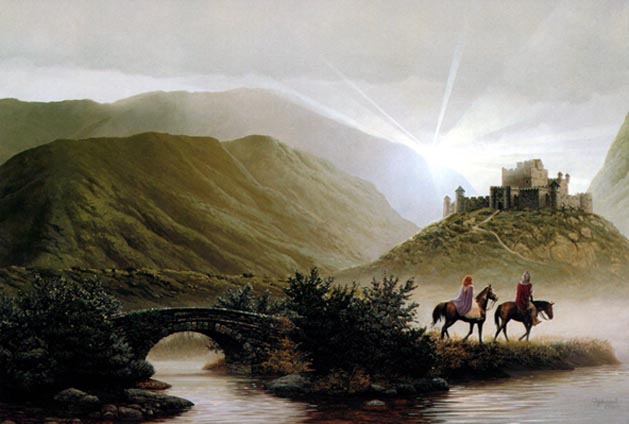pg. 1 - Epitaph | pg. 2 - The Iron Gates of Fate
pg. 3 - The Fate of All Mankind | pg. 4 - Moonchild
pg. 5 - The Court of the Crimson King | pg. 6 - The Purple Piper
pg. 7 - Averroes | pg. 8 - The Keeper of the City Keys
pg. 9 - The Pilgrim's Door | pg. 10 - The Return of the Fire Witch
pg. 11 - The Gardener Plants An Evergreen | pg. 12 - The Prism Ship
pg. 13 - The Grinding Wheel | pg. 14 - On Soft Gray Mornings
pg. 15 - Divining Signs | pg. 16 - The Yellow Jester
pg. 17 - Remember the Future | pg. 18 - The Return of the King
pg. 19 - The I Ching | pg. 20 - Octants
- page index -
In the Court of the Crimson King
site index
Translate from
Sun symbolism also explains the dramatic segue between Moonchild and The Court of the Crimson King . The long instrumental passage of Moonchild represents the night. Vague forms are evoked, as if in a dream, and then, like the sun breaking over the horizon, or into Castel del Monte, The Court of the Crimson King comes roaring into view.
"The transition from 17.Moon to 18.Sun represents the alchemical Magnum Opus. The sea of 17.Moon is saturated with the alchemical salt, whose corrosiveness represents the Nigredo (Blackening), which reduces the soul to prime matter. The sun represents the alchemical Sulphur, the libido, the psychic life force, the generative and transformative power, and as the solar disk appears over the horizon we enter the Citrinitas (Yellowing), in which the prime matter is ennobled. When the sun reaches the zenith, the Rubedo (Reddening) is achieved, which is the highest state."
- The Pythagorean Tarot by John Opsopaus
The Court of the Crimson King
-
- "Immense, august, like some Titanic bloom,
- The mighty choir unfolds its lithic core,
- Petalled with panes of azure, gules and or,
- Splendidly lambent in the Gothic gloom,
- And stamened with keen flamelets that illume
-
The pale high-alter."
-
- Edith Wharton, Chartres
"This is a place of awe. Here is the court of God and the gate of heaven"
- words intoned in the Mass at the opening of Chartres in 1260
"The Castel del Monte, on its lofty site near Barletta, is the best preserved and the best known of the Hohenstaufen castles. It's ground-plan is unique, and like many other of the Emperor's buildings it was probably sketched by Frederick himself. Every fraction of the structure displays the mental catholicity of the Hohenstaufen court : oriental massiveness of the whole, a portal foreshadowing the Renaissance, Gothic windows and rooms with groined and vaulted roofs. The defiant gloom of the tiny windowed rooms was mitigated by the furnishings ; the floors were of mosaic ; the walls covered with sheets of reddish breccia or white marble. Majesty and grace were fused in one." (p. 322)
- Frederick II
by Ernst Kantorowicz
"Among the visitors to Castel del Monte there are not many who notice one diffuse symbol involved and invested in the entire fabric of the structure. This "protagonist " is the red color that, in its more tenuous shadings, appears in the rosato and carnicine marble and in the limestone of the walls. It then prevails within the unforeseeable arabesques of the showy coralline breccia...until definitively surprising in the unusual blood chiazzature of the cipollino marble columns which support the symbolically celestial cupola."
- The Color of Castel del Monte

The Castle of the Crimson King
"Frederick meant men to revere his state as an 'imperial church' (imperialis ecclesia),
in which he himself was the high priest of justice..."
- The Holy Roman Empire
by Friedrich Heer (p. 84)
























 Arachnophilia
Arachnophilia